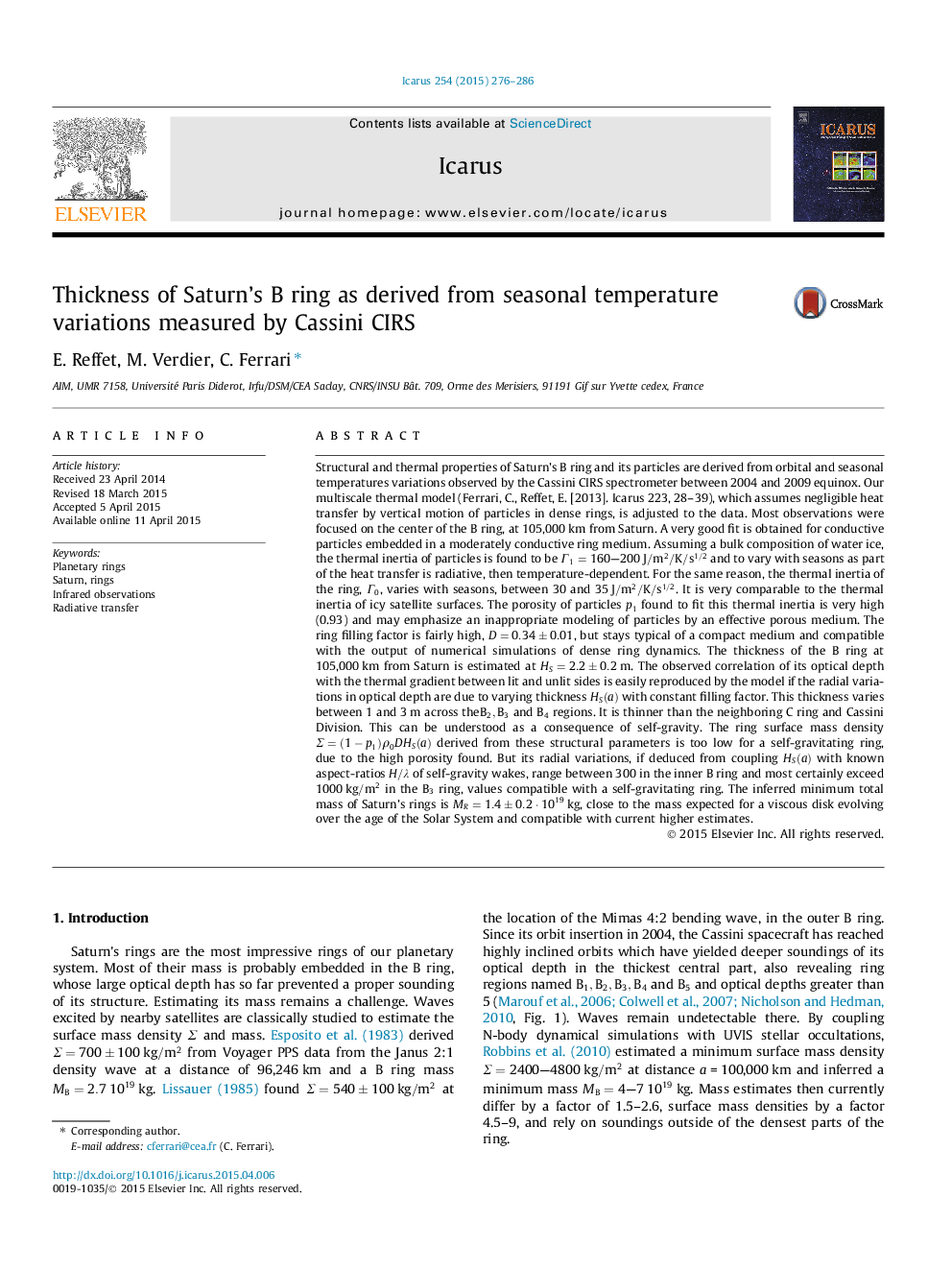| کد مقاله | کد نشریه | سال انتشار | مقاله انگلیسی | نسخه تمام متن |
|---|---|---|---|---|
| 8136330 | 1523536 | 2015 | 11 صفحه PDF | دانلود رایگان |
عنوان انگلیسی مقاله ISI
Thickness of Saturn's B ring as derived from seasonal temperature variations measured by Cassini CIRS
دانلود مقاله + سفارش ترجمه
دانلود مقاله ISI انگلیسی
رایگان برای ایرانیان
کلمات کلیدی
موضوعات مرتبط
مهندسی و علوم پایه
علوم زمین و سیارات
علوم فضا و نجوم
پیش نمایش صفحه اول مقاله

چکیده انگلیسی
Structural and thermal properties of Saturn's B ring and its particles are derived from orbital and seasonal temperatures variations observed by the Cassini CIRS spectrometer between 2004 and 2009 equinox. Our multiscale thermal model (Ferrari, C., Reffet, E. [2013]. Icarus 223, 28-39), which assumes negligible heat transfer by vertical motion of particles in dense rings, is adjusted to the data. Most observations were focused on the center of the B ring, at 105,000 km from Saturn. A very good fit is obtained for conductive particles embedded in a moderately conductive ring medium. Assuming a bulk composition of water ice, the thermal inertia of particles is found to be Î1=160-200J/m2/K/s1/2 and to vary with seasons as part of the heat transfer is radiative, then temperature-dependent. For the same reason, the thermal inertia of the ring, Î0, varies with seasons, between 30 and 35 J/m2/K/s1/2. It is very comparable to the thermal inertia of icy satellite surfaces. The porosity of particles p1 found to fit this thermal inertia is very high (0.93) and may emphasize an inappropriate modeling of particles by an effective porous medium. The ring filling factor is fairly high, D=0.34±0.01, but stays typical of a compact medium and compatible with the output of numerical simulations of dense ring dynamics. The thickness of the B ring at 105,000 km from Saturn is estimated at HS=2.2±0.2 m. The observed correlation of its optical depth with the thermal gradient between lit and unlit sides is easily reproduced by the model if the radial variations in optical depth are due to varying thickness HS(a) with constant filling factor. This thickness varies between 1 and 3 m across theB2,B3 and B4 regions. It is thinner than the neighboring C ring and Cassini Division. This can be understood as a consequence of self-gravity. The ring surface mass density Σ=(1-p1)Ï0DHS(a) derived from these structural parameters is too low for a self-gravitating ring, due to the high porosity found. But its radial variations, if deduced from coupling HS(a) with known aspect-ratios H/λ of self-gravity wakes, range between 300 in the inner B ring and most certainly exceed 1000 kg/m2 in the B3 ring, values compatible with a self-gravitating ring. The inferred minimum total mass of Saturn's rings is MR=1.4±0.2·1019 kg, close to the mass expected for a viscous disk evolving over the age of the Solar System and compatible with current higher estimates.
ناشر
Database: Elsevier - ScienceDirect (ساینس دایرکت)
Journal: Icarus - Volume 254, 1 July 2015, Pages 276-286
Journal: Icarus - Volume 254, 1 July 2015, Pages 276-286
نویسندگان
E. Reffet, M. Verdier, C. Ferrari,